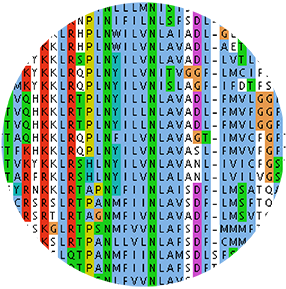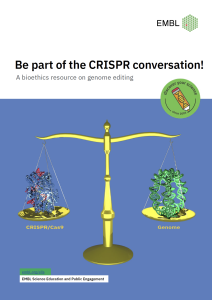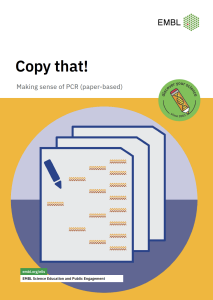
Step 4: Comparison of amino acid sequences
Overview
In this part of the activity, we will feed two of the protein sequences which we have generated in the previous step into the EMBL-EBI MUSCLE alignment tool to check the similarity between these two fluorescent proteins. A sequence alignment based on the amino acid sequence gives a stronger hint towards their similarity than a nucleotide sequence. The alignment allows us to visualise additions, deletions or exchanges within the amino acid sequences. It also allows to find amino acid residues or stretches which have been strongly conserved during evolution.
After completing this task, you will have produced a multiple sequence alignment on protein level and you will be able to roughly estimate where and what the differences between our two sequences are.
Your task
Proceed as described below:
- Copy all of the amino acid sequences which are provided under the tab “Amino acid sequences” (i.e. select and copy the whole block of sequences) (shortcut Ctrl. + C).
- Paste the amino acid sequences into the MUSCLE search box (shortcut Ctrl. + V).
- Follow the instructions in the tab “MUSCLE” to align your sequences.
- Have a look at the alignment and try to answer the task questions.
MUSCLE
- Copy all of the amino acid sequences which are provided under the tab “Amino acid sequences” (i.e. select and copy the whole block of sequences) (shortcut Ctrl. + C).
- Paste the amino acid sequences into the MUSCLE search box (shortcut Ctrl. + V).
- In the “STEP 2” section ensure that “Output Format” is set at “ClustalW”.
- Just click on the large “Submit” button and your alignment will be processed.
- You will see the results after a few seconds.
- Have a look at the alignment and try to answer the questions in the “Questions” tab
Amino acid sequences
Protein sequence 1
>Protein_Sequence1_AVGFP_1
MSKGEELFTGVVPVLVELDGDVNGQKFSVSGEGEGDATYGKLTLNFICTTGKLPVPWPTLVTTFSYGVQCFSRYPDHMKQHDFFKSAMPEGYVQERTIFYKDDGNYKTRAEVKFEGDTLVNRIELKGIDFKEDGNILGHKMEYNYNSHNVYIMGDKPKNGIKVNFKIRHNIKDGSVQLADHYQQNTPIGDGPVLLPDNHYLSTQSALSKDPNEKRDHMILLEFVTAARITHGMDELYK
Protein sequence 2
>Protein_Sequence2_GFPm_1
MSKGEELFTGVVPILVELDGDVNGHKFSVSGEGEGDATYGKLTLKFICTTGKLPVPWPTLVTTFGYGVQCFARYPDHMKQHDFFKSAMPEGYVQERTIFFKDDGNYKTRAEVKFEGDTLVNRIELKGIDFKEDGNILGHKLEYNYNSHNVYIMADKQKNGIKVNFKIRHNIEDGSVQLADHYQQNTPIGDGPVLLPDNHYLSTQSALSKDPNEKRDHMVLLEFVTAAGITHGMDELYK
Questions
Have a look at the protein alignment and try to answer the following questions:
- How do you know whether the amino acid residues in the individual sequences are the same or not compared to the other aligned sequences?
- Do you think there many corresponding amino acids? Are there more similarities compared to the respective nucleotide alignments?
- What do you think are the reasons for these changes?
Activity navigation

Share:
 Čeština
Čeština Français
Français Ελληνικά
Ελληνικά Italiano
Italiano Svenska
Svenska


